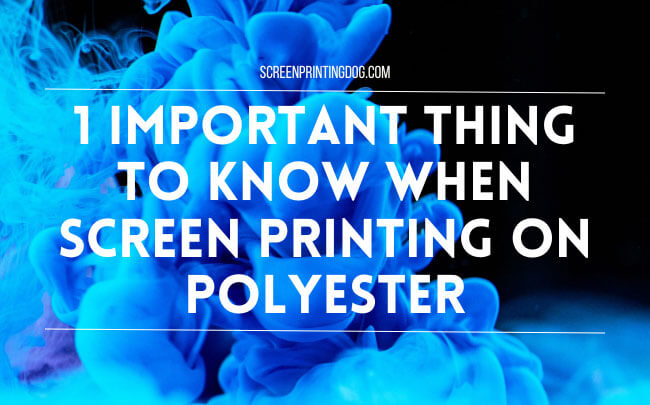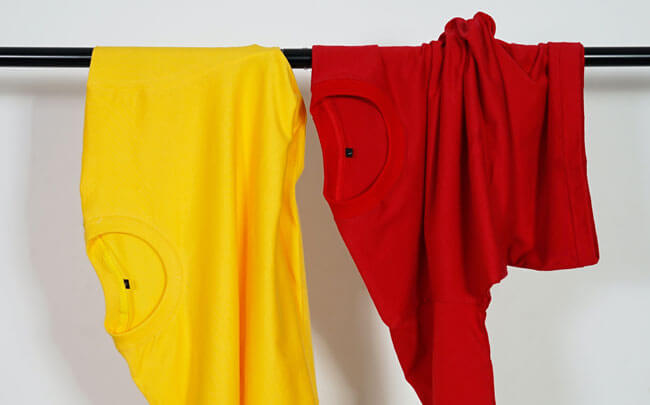
So someone approached you and asked if you can print up some dri-fit t-shirts, maybe a team jersey or even sports jackets for their son’s little league. You have never done them before, heck, you don’t even know if screen printing on polyester is possible…
But because of your can-do attitude, you enthusiastically tell your client that you can deliver, and now you’re here. Well, good on you! Because learning how to screen print on polyester can in fact quadruple your profits!
From athletic wear to swimwear, outerwear to dresses and skirts, polyester is a popular fabric choice known for its durability, wrinkle-resistance, and moisture-wicking properties.
However, screen printing on polyester can sometimes get a bad rep. Many budding screen printers have left the game especially if common mistakes like using the wrong type of ink, using the wrong mesh count, overloading the ink, and using improper curing techniques, are made.
In this article, I’ll help you stay sane and show you the ins and outs of screen printing on polyester, including best practices, mistakes to avoid, and tips for achieving vibrant and long-lasting results.
The biggest issue with screen printing on polyester
Particularly when screen printing on polyester, the most concerning problem that occurs is when the dye from the garment starts to shift and bleed into the ink, causing the color to alter, distort, or even fade. This issue is commonly known as dye migration.
The problem happens during the curing process, when high heat nudges the dye of the fabric to travel. The eventual blending in with the ink creates a hair pulling moment for screen printers and will ruin an otherwise perfect print.
Dye migration is noticeably worse with white ink on red colored garments. Therefore, proper ink selection and curing techniques with the right temperature are needed to minimize or eliminate this.
Polyester blends
When screen printing on fabric with high polyester content such as 50/50 or 60/40, it is recommended to use a low-bleed polyester ink or a polyester-specific white underbase, followed by color on top.
100% polyester
For 100% polyester garments, you can print a layer or two of a bleed blocker as an underbase, followed by any colored print on top. Bleed blockers will assure peace of mind and allow you to print with regular ink that cures at normal temperatures.
Best screen printing ink for polyester
When it comes to screen printing on polyester fabrics, ink with a high viscosity such as plastisol typically gives you the best results as it ensures proper adhesion and curing.
Rapid Cure produces a line of low temperature, low cure screen printing plastisol ink. Their Polyester White underbase is specifically for screen printing on polyester. So if you’re looking to start printing or customizing your own plastisol transfers, check them out first.
But if you are conscious of the solvents in plastisol ink and insist on using a PVC-free alternative, there are water-based options in the market. Though they require additional prep work and in my experience, haven’t really worked well.
You see, water-based ink really shines when it’s absorbed and bonded with the fabric. But since polyester fabric is naturally anti-water, the two don’t really mix well, especially if it’s 100% polyester. Add this to the hurdle of curing, and well, you’ve got a proper future headache.
One method of getting around this involves mixing a low-cure additive into regular water-based ink so that it cures at a lower temperature. The lower temperature means a lowered risk of dye migration caused by heat.
Green Galaxy makes a low cure additive that can be used with their line up of water-based ink. The additive dramatically lowers the curing temp from 330˚ to 180˚ Fahrenheit and if you’re looking for a soft hand feel on polyester, this is your best bet.
Now that we’ve gotten the hardest part out of the way, some of you might still be wondering.
Is screen printing on polyester the same as regular screen printing?

The short answer is yes.
Aside from the modifications required to address dye migration, the basic concept of screen printing remains the same regardless of fabric type. There are also other elements that you can consider tweaking in case you run into any difficulties.
Mesh count
Depending on the ink and how intricate the design is, I’ve used a screen with a lower mesh count with better vibrancy and results overall. Keep in mind, I was printing block-ish company logos on 50/50 polo tees. The larger holes in the screen allow for more ink penetration and adhesion to the fabric. So instead of the typical 110 mesh count, I would often use mesh’s between 80-90. My suggestion is to experiment to find the right balance.
Squeegee
Whether you’re pulling or pushing your squeegee, consider changing your squeegee blade or squeegee angle to achieve sharper prints, especially if you’re working with multiple passes of white underbase. I use a 1.5” blade height at a 70-75 degree angle.
The idea here is to push just enough ink so the final print will have a soft hand feel yet still vibrant and clear, instead of depositing too much ink. Keep in mind, ink type will play a role in how you position your squeegee. Perfecting this will obviously require practice.
Off-contact
I wrote an entire post on this previously, and is an easy tweak to getting better prints. Adjusting off-contact will give you the much needed screen slack or tension to prevent over ink overload.
Wrap up
As you already know, the biggest hurdle when it comes to screen printing on polyester is dye migration. Get over this with the proper ink and curing techniques, and you’ll be guaranteed a win.
I’m certain with a few more tweaks, you’ll be able to produce vibrant and long lasting prints for yourself and your clients!
